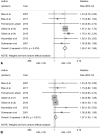Kaplan-Meier Survival Analysis Overestimates the Risk of Revision Arthroplasty: A Meta-analysis
- PMID: 25804881
- PMCID: PMC4586188
- DOI: 10.1007/s11999-015-4235-8
Kaplan-Meier Survival Analysis Overestimates the Risk of Revision Arthroplasty: A Meta-analysis
Abstract
Background: Although Kaplan-Meier survival analysis is commonly used to estimate the cumulative incidence of revision after joint arthroplasty, it theoretically overestimates the risk of revision in the presence of competing risks (such as death). Because the magnitude of overestimation is not well documented, the potential associated impact on clinical and policy decision-making remains unknown.
Questions/purposes: We performed a meta-analysis to answer the following questions: (1) To what extent does the Kaplan-Meier method overestimate the cumulative incidence of revision after joint replacement compared with alternative competing-risks methods? (2) Is the extent of overestimation influenced by followup time or rate of competing risks?
Methods: We searched Ovid MEDLINE, EMBASE, BIOSIS Previews, and Web of Science (1946, 1980, 1980, and 1899, respectively, to October 26, 2013) and included article bibliographies for studies comparing estimated cumulative incidence of revision after hip or knee arthroplasty obtained using both Kaplan-Meier and competing-risks methods. We excluded conference abstracts, unpublished studies, or studies using simulated data sets. Two reviewers independently extracted data and evaluated the quality of reporting of the included studies. Among 1160 abstracts identified, six studies were included in our meta-analysis. The principal reason for the steep attrition (1160 to six) was that the initial search was for studies in any clinical area that compared the cumulative incidence estimated using the Kaplan-Meier versus competing-risks methods for any event (not just the cumulative incidence of hip or knee revision); we did this to minimize the likelihood of missing any relevant studies. We calculated risk ratios (RRs) comparing the cumulative incidence estimated using the Kaplan-Meier method with the competing-risks method for each study and used DerSimonian and Laird random effects models to pool these RRs. Heterogeneity was explored using stratified meta-analyses and metaregression.
Results: The pooled cumulative incidence of revision after hip or knee arthroplasty obtained using the Kaplan-Meier method was 1.55 times higher (95% confidence interval, 1.43-1.68; p < 0.001) than that obtained using the competing-risks method. Longer followup times and higher proportions of competing risks were not associated with increases in the amount of overestimation of revision risk by the Kaplan-Meier method (all p > 0.10). This may be due to the small number of studies that met the inclusion criteria and conservative variance approximation.
Conclusions: The Kaplan-Meier method overestimates risk of revision after hip or knee arthroplasty in populations where competing risks (such as death) might preclude the occurrence of the event of interest (revision). Competing-risks methods should be used to more accurately estimate the cumulative incidence of revision when the goal is to plan healthcare services and resource allocation for revisions.
Figures


Comment in
-
CORR Insights(®): Kaplan-Meier Survival Analysis Overestimates the Risk of Revision Arthroplasty: A Meta-analysis.Clin Orthop Relat Res. 2015 Nov;473(11):3443-5. doi: 10.1007/s11999-015-4291-0. Epub 2015 Apr 11. Clin Orthop Relat Res. 2015. PMID: 25861791 Free PMC article. No abstract available.
Similar articles
-
What Can We Learn From 20-year Followup Studies of Hip Replacement?Clin Orthop Relat Res. 2016 Feb;474(2):402-7. doi: 10.1007/s11999-015-4260-7. Clin Orthop Relat Res. 2016. PMID: 25800375 Free PMC article.
-
What Is the Rerevision Rate After Revising a Hip Resurfacing Arthroplasty? Analysis From the AOANJRR.Clin Orthop Relat Res. 2015 Nov;473(11):3458-64. doi: 10.1007/s11999-015-4215-z. Clin Orthop Relat Res. 2015. PMID: 25721576 Free PMC article.
-
Competing Risk of Death When Comparing Tibial Implant Types in Total Knee Arthroplasty.J Bone Joint Surg Am. 2016 Apr 6;98(7):591-6. doi: 10.2106/JBJS.15.00488. J Bone Joint Surg Am. 2016. PMID: 27053588
-
Kaplan-Meier survival analysis overestimates cumulative incidence of health-related events in competing risk settings: a meta-analysis.J Clin Epidemiol. 2018 Jan;93:25-35. doi: 10.1016/j.jclinepi.2017.10.006. Epub 2017 Oct 16. J Clin Epidemiol. 2018. PMID: 29045808
-
The Impact of Neuraxial Versus General Anesthesia on the Incidence of Postoperative Surgical Site Infections Following Knee or Hip Arthroplasty: A Meta-Analysis.Reg Anesth Pain Med. 2016 Sep-Oct;41(5):555-63. doi: 10.1097/AAP.0000000000000437. Reg Anesth Pain Med. 2016. PMID: 27380106 Review.
Cited by
-
What can we learn from AOANJRR 2014 annual report?Ann Transl Med. 2015 Jun;3(10):131. doi: 10.3978/j.issn.2305-5839.2015.05.04. Ann Transl Med. 2015. PMID: 26207224 Free PMC article. No abstract available.
-
The learning curve of the direct anterior approach is 100 cases: an analysis based on 15,875 total hip arthroplasties in the Dutch Arthroplasty Register.Acta Orthop. 2022 Sep 27;93:775-782. doi: 10.2340/17453674.2022.4802. Acta Orthop. 2022. PMID: 36173140 Free PMC article.
-
Long-Term Implant Survivorship and Modes of Failure in Simultaneous Concurrent Bilateral Total Knee Arthroplasty.J Arthroplasty. 2020 Jan;35(1):139-144. doi: 10.1016/j.arth.2019.08.011. Epub 2019 Aug 14. J Arthroplasty. 2020. PMID: 31500911 Free PMC article.
-
The Cox model is better than the Fine and Gray model when estimating relative revision risks from arthroplasty register data.Acta Orthop. 2017 Dec;88(6):578-580. doi: 10.1080/17453674.2017.1361130. Epub 2017 Aug 3. Acta Orthop. 2017. PMID: 28771059 Free PMC article.
-
Dual mobility cups in primary total hip arthroplasties: trend over time in use, patient characteristics, and mid-term revision in 3,038 cases in the Dutch Arthroplasty Register (2007-2016).Acta Orthop. 2019 Feb;90(1):11-14. doi: 10.1080/17453674.2018.1542210. Epub 2018 Nov 19. Acta Orthop. 2019. PMID: 30451041 Free PMC article.
References
-
- Abraira V, Muriel A, Emparanza JI, Pijoan JI, Royuela A, Plana MN, Cano A, Urreta I, Zamora J. Reporting quality of survival analyses in medical journals still needs improvement. A minimal requirements proposal. J Clin Epidemiol. 2013;66(1340–1346):e5. - PubMed
-
- Australian Orthopaedic Association National Joint Replacement Registry. Annual Report 2013. Adelaide, Australia: AOA; 2013. Available at: https://aoanjrr.dmac.adelaide.edu.au/annual-reports-2013. Accessed February 4, 2014.
Publication types
MeSH terms
LinkOut - more resources
Full Text Sources
Other Literature Sources
Medical
Miscellaneous

